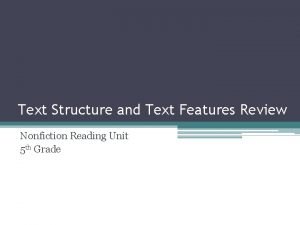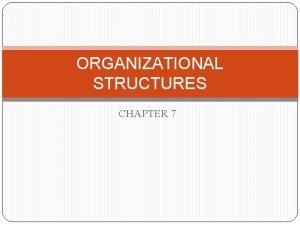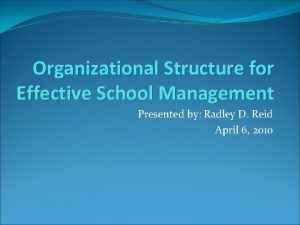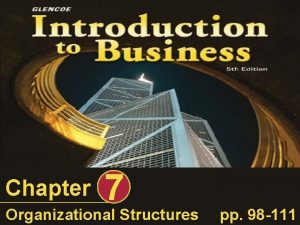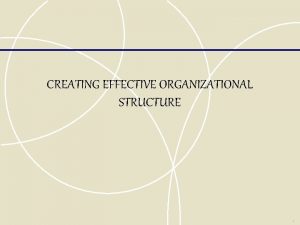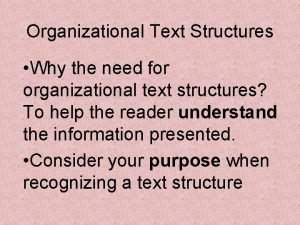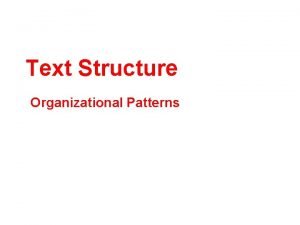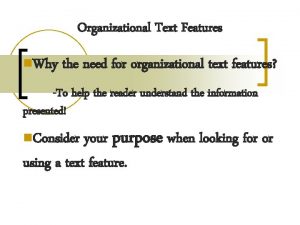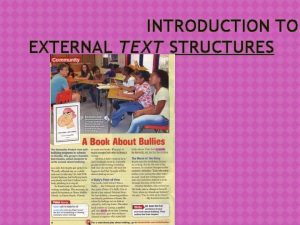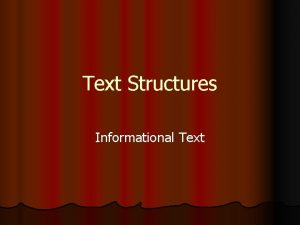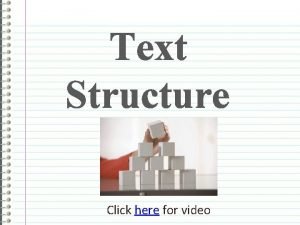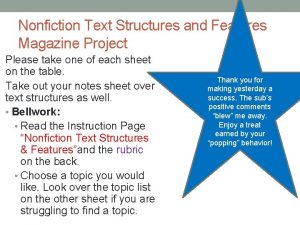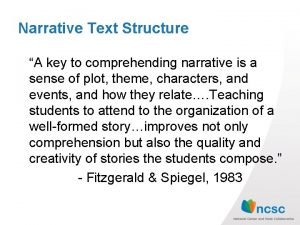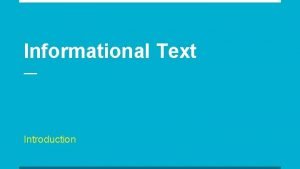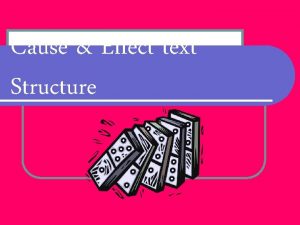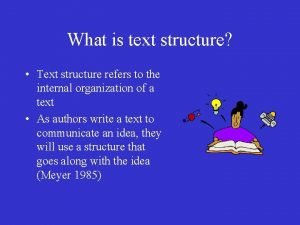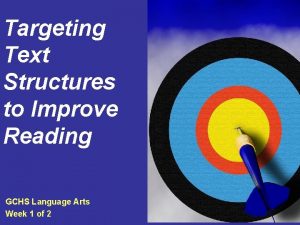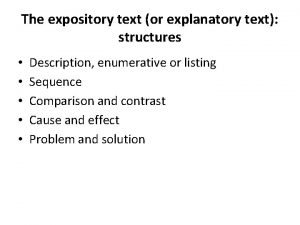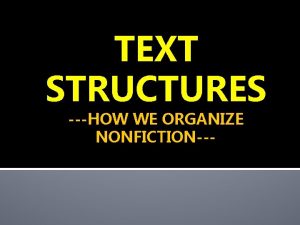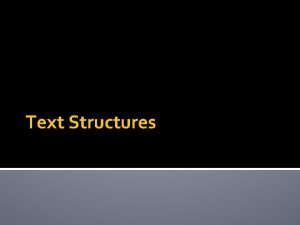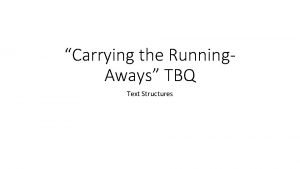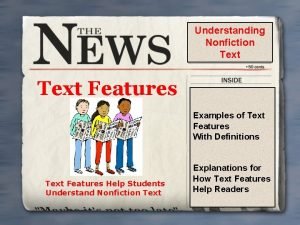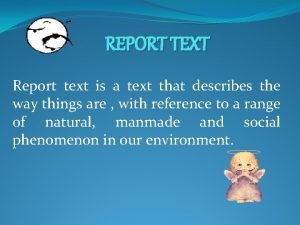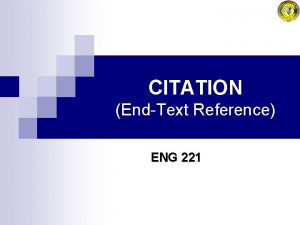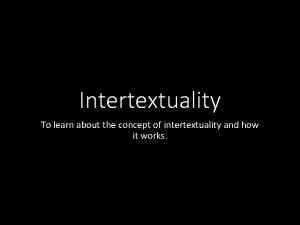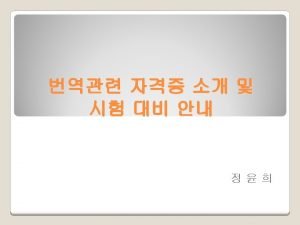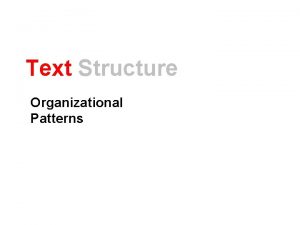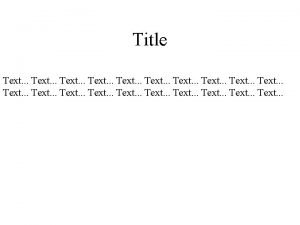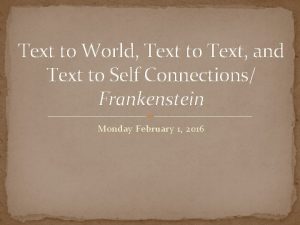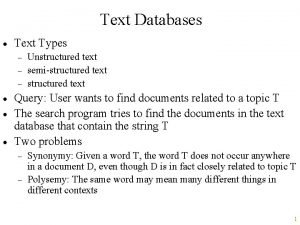Organizational Structures Text Structures Organizational Structures a k





































- Slides: 37

Organizational Structures Text Structures Organizational Structures (a. k. a. Text Structures) are different ways for writers to present or organize information; for example, using description, comparing or contrasting, using chronological order, giving cause and effect, etc. Ø Text structure refers to the way information is presented or organized. Ø

Author’s Purpose Ø An author chooses a particular structure for organizing his work based on his/her purpose. In other words, the author’s reason for writing may determine the method he/she uses. Ø For example, if an author wants to write about the health benefits of drinking green tea, he might want to describe all of those benefits; however, he may choose to compare green tea to black tea Ø It can be important for a reader to identify the author’s reasons for writing. Here are some of the general purposes an author chooses to write:

Author’s Purpose Ø To entertain Ø To inform Ø To persuade (to sell) Ø To explain Ø To instruct Ø To inspire Ø To encourage Ø To complain

Description Ø A common way for a writer to present information is by using description. Description can be used for many different purposes: Ø An ad may describe a product to entice someone to buy it. Ø Stories use description to create setting and to develop characters. Ø An employee manual may describe a job so workers can understand what is required.

Ø A wildlife magazine article may describe the steps that are being taken to protect an endangered species. Ø A television advertisement for a political candidate may describe the candidate’s record of achievement. Ø NOW YOU TRY IT:

Read this paragraph: Ø The man who sat in the little wooden summer -house that faced the sea raised his head from his hand stared outwards. The signal had scarcely penetrated to his inner consciousness, but it had vaguely disturbed his train of thought. His eyes were dull and emotionless as he stared across the blue, smiling water to the long, straight line of the horizon. They were heavy also as if he had not slept for weeks, and there were deep lines about his clean-shaven mouth.

What is the author’s purpose for using description in this paragraph? To persuade the reader to like the old man 2. To inspire the reader to rent a summerhouse 3. To establish setting and describe a character 4. To explain what it takes to be a lighthouse keeper 1.

Read this paragraph: Ø The office receptionist has many important job responsibilities. The receptionist must greet all incoming clients, answer their questions, and direct them to the appropriate personnel. He or she must also effectively manage, screen, and route all incoming calls on a three-line phone system. The person who fills this position must be courteous and professional, and he or she must be able to remain calm in stressful situations.

What is the author’s purpose for using description in this paragraph? 1. 2. 3. 4. To explain why a person should go to college To explain job requirements of the office receptionist To establish setting and describe a character To persuade someone to apply for the job of receptionist

Read this paragraph: Ø Have you tried the new product on the market called Wonder. Skin? If you haven’t, you’re missing out on the best-looking skin of your life. Wonder. Skin removes all unsightly pimples and zits and keeps them away. It also erases any scars that were made by acne. One application daily will have your skin clear in just a few days. You won’t believe the difference in your skin! Try Wonder. Skin today and see what you’ve been missing!

What is the author’s purpose for using description in this paragraph? 1. 2. 3. 4. To explain why a person should take care of his/her skin To demonstrate to customers why their old skin product isn’t working for them To establish setting To persuade someone to purchase the product called Wonder. Skin

Compare and Contrast Ø Compare—to explain or describe similarities Ø Contrast—to explain or describe differences Ø Another way a writer may choose to organize his details is through comparing and/or contrasting. He can do both comparing and contrasting; or he just compare or just contrast. Ø Look for transition words! However, on the other hand, in the same way, like, as opposed, but, different, although, yet, similarly, etc.

Read this paragraph: Ø Jackie was not like most high school students at Glennville High because she was born with no arms. Most students sling a backpack over their shoulder with ease, but she barely had enough shoulders on which to hang her book bag. She never complained about being different and was an amazing person to watch in and out of class. Jackie’s desk was different from the other student desks because it was only about a foot high, slanted so that she could use her feet

like the other students used their hands. She ate, applied lipstick, wrote, and turned the pages of her book with her feet. When she entered the classroom, Jackie put her book bag on her chair and used her feet to open it and take out the materials she would need for class as opposed to other students who were socializing in the hall. Ø Is this paragraph a comparison? Ø No, it is a contrast! What is being contrasted here? (Go back and locate the transitional words. )

Read this paragraph: Ø Although she was different in many ways, Jackie was still an adventurous teenager, and she got into her share of trouble just like many other students at her school. She had a fondness for cutting classes, talking, and ignoring her homework assignments. She even got caught cheating in Algebra class, an even more serious offense. The principal didn’t take Jackie’s infractions lightly, and she was rightly punished.

He required that she go to in-school suspension class for the same amount of time as any other student caught doing such things. Ø Is this a comparison? Ø Yes. What is being compared? (Go back and locate the clue words {transitional words and phrases}. )

Read this paragraph: Ø Jacob and Jordan are alike in some ways but very different in others. They are identical twins, and they look exactly alike; however, Jordan is about two pounds heavier than Jacob. Jordan likes to sing and dance, but Jacob would rather watch cartoons on television. Jacob will wear whatever his mother wants him to wear. Jordan, on the other hand, wants to choose his own clothes every day. Both boys like cereal for breakfast, and they take up for each other when they get into trouble. Jacob's favorite color is red, but Jordan likes blue better. They may look exactly alike, but often they are very different little boys.

Ø What type of organizational structure did this author use? Ø He used both comparison and contrasts. Notice how similarities AND differences are pointed out.

Order: (1) Sequential Order (a. k. a. Chronological Order) Ø This organizational structure organizes events in the same order as they occurred in time. Ø This type of order is often used for narrating a story or when writing a biography. Ø When a writer uses chronological order, it is easy to determine the sequence of events. Ø Look for words like first, then, next, after, before, and last.

Ø HOWEVER, understand that other types of organizational structures might use those same words. For example, process order. Just because you see the words first, next, then etc. , does not guarantee that chronological order is being used! Ø Also, look for dates or days. On July 7 th, or on Tuesday…. . Ø BIG HINT: If you are reading a “story” (someone telling you what happened) you are PROBABLY seeing sequential order!!

Read this paragraph: Ø After his family moved from Clarksdale, Mississippi, to Chicago in 1933, Sam Cooke began singing gospel music with his siblings. In 1945, a teenaged Cooke joined the gospel group called The Highway QCs. Five years later, he earned a spot with the Soul Stirrers, a major gospel quartet. The group worked its way to the top of gospel music by 1955, but Sam wasn’t satisfied. The nineteen-year-old wanted to make music for a wider audience, so he recorded the pop single, “Lovable” in 1956. Cooke then quit Specialty Records,

His recording label, because the head of the company began arguing with Cooke over the music he had started recording. In 1957, he joined Keen Records and scored number one in the Billboard ratings with the pop single, “You Send Me. ” Over the next six years, Cooke started his own record label and publishing company, and he recorded twenty-nine Billboard Top 40 hits, including classics like, “Chain Gang, ” “Twistin’ the Night Away, ” and “(What a) Wonderful World. ”

Read this paragraph: Ø By the panicked look on Mr. Bramlett’s face, everyone knew that something had escaped from the science room where Mr. Bramlett kept a menagerie of various critters. He warned each teacher coming into the building that his largest black snake was loose. He emphasized that he would like to get his snake back unharmed if possible because he used it to teach certain sections in his science book. After hearing his pleas, every teacher approached his or her

Classroom with dread and secretly hoped the snake was gone. Several hours passed, the snake still had not turned up, and everyone thought it had escaped the building. Mrs. Keenan, who had arrived late that morning because of a doctor’s appointment, had received no warning about the missing snake. Upon turning around to write an example on the chalkboard, she came face to face with the black serpent. Her terrified scream filled the halls and brought Mr. Bramlett running to the rescue. After

retrieving his snake, he then had to catch Mrs. Keenan who was running full speed down the hall. Ø Both of these paragraphs use sequential order. Ø The first gives a biography of Sam Cooke and uses obvious dates to show the chronological order of the details. Ø The second simply relates a story, but the details are given in the order that they happened; therefore, sequential order is used.

Order (2) Process Order (a. k. a. Procedural Order) Ø This is similar to sequential order, but instead of giving events in the order that they occurred, a writer explains the steps of a process in the order they should be performed. Ø BE CAREFUL: Many times a writer will use the words first, second, then, next, etc. Do not get this confused with sequential order!

Ø Often, the first line will read something like, “Having a beautiful garden is easy if you follow these simple steps. ” Ø “Changing the oil in your lawn mower is easy if you follow the following steps. ”

Order: (3) Order of Importance Ø This organizational structure uses reasons or details in an order from either least important to most important, or from most important to least important. Ø Many times, this is seen in persuasive writing where the author gives the most persuasive reason first, or he saves the most persuasive detail for last.

Read this paragraph: Ø Lose-It brand green tea is the number one weight loss tea in the world. One reason for its success is its superior taste. It tastes so good that many people prefer it over sugary or artificially sweetened sodas. Its great taste makes it fun to drink every day, and the more you drink, the more weight you lose. But losing weight and feeling great are about much more than just taste. Lose-It green tea also promotes good health with its high concentration of EGCG, a powerful antioxidant. EGCG protects

Cardiovascular health and can even help prevent some types of cancer. The healthier the body, the easier it is to lose weight. But that’s not all. The most important weight loss property of Lose-It green tea is found in its high catechin content (EGCG being just one of those catechins). Catechins raise metabolism, allowing you to burn more calories, and they also inhibit fat formation. This powerful one-two punch allows you to melt away those excess pounds. Ø This paragraphs builds from least important reason to most important reason.

Order (4) Spatial Order Ø Spatial order deals with SPACE. Items are described according to their position. Ø Look for words like across from, next to, beside, to the right of, etc.

Read this paragraph: Ø Stepping into the bathroom was like entering an expensive spa. To the right was a high mauve garden tub surrounded by both green and flowering plants of all shapes and sizes. Straight ahead, to the left of the tub, was a large, stand-alone shower with golden showerheads mounted on both sides. On the left side of the room, across from the bathtub, were double sinks mounted in a vanity of highly polished marble. A wall-length mirror above the vanity reflected the light and made the luxurious bathroom appear even larger.

Cause and Effect Ø This organizational structure presents a relationship that explains how one thing makes something else happen. Ø Causes and effects may be directly stated, or they may be implied. Ø KEY WORDS to show cause: Because, the cause is, due to, first, for, since. . . Ø KEY WORDS to show effect: As a result, consequently, resulted in, the result is, therefore, thus. . .

Read this paragraph: Ø Atlanta has experienced a drought for three years. As a result, water restrictions burden the residents in all metropolitan counties. Grass and other plants have probably been the most affected. The drought is so severe that watering lawns is permitted for only twenty-five minutes and only once per week. The watering must be done only by hand without the help of an automatic sprinkler, and all watering must be done between the hours of midnight and ten a. m.

Problem Solution Ø This organizational structure presents a relationship that shows how a conflict (the problem) or issue is answered (the solution). Ø Note that sometimes the solution is not a guaranteed solution. Perhaps you are making bad grades, so you decide to spend more time studying. One can assume that this is the solution to the problem, but the evidence does not have to be presented in the text.

Read this paragraph: Ø Snickers, Jessica’s puppy, loved to ride in the car; however, she was terrified of the car’s windshield wipers. The last ride she had taken was during a rainstorm. Growling and barking hysterically, Snickers suffered through several miles as she nervously watched the wipers go back and forth. Traveling in the rain was a chore, no matter what the distance. Jessica decided to try something new so that she could take Snickers on long trips without having to worry about the weather. She bought a carrier

that had mesh on one side, was solid on the other side, and had zippers on both ends. She could put Snickers in the carrier and still hold it on her lap with the solid side of the carrier towards the windshield. If Snickers wanted to be petted, Jessica could unzip the end of the carrier to pet and comfort the animal. Now when rain starts to splatter on the windshield, Snickers looks for the carrier and quickly climbs into it.
 Text to text text to self text to world
Text to text text to self text to world Text features
Text features Chapter 7 organizational structures
Chapter 7 organizational structures Organizational structure of the school
Organizational structure of the school Chapter 7 organizational structures
Chapter 7 organizational structures Influences of organizational structures on projects
Influences of organizational structures on projects Sbu organizational structure
Sbu organizational structure Examples of homologous
Examples of homologous Internal text structure
Internal text structure Spatial text structure
Spatial text structure Enumeration/listing text structure examples
Enumeration/listing text structure examples Organizational text features
Organizational text features What are text features
What are text features Problem and solution transition words
Problem and solution transition words Identify the text type
Identify the text type Type of text structures
Type of text structures What is an external text structure
What is an external text structure Problem and solution signal words
Problem and solution signal words Video on text structure
Video on text structure Text structure project
Text structure project What are the structures narrative text? *
What are the structures narrative text? * Flocabulary text structure
Flocabulary text structure Cause and effect structure words
Cause and effect structure words Common text structures and transition words
Common text structures and transition words Compare and contrast examples
Compare and contrast examples Expository text structures
Expository text structures External text structures
External text structures External text features
External text features What is the text structure
What is the text structure Map text feature example
Map text feature example 2 texte nonliterare
2 texte nonliterare Report text structure
Report text structure Surface connection and deep connection
Surface connection and deep connection Text _____ in a nonfiction text is its organization.
Text _____ in a nonfiction text is its organization. End of text reference
End of text reference What is intertextuality
What is intertextuality Annotation symbols for close reading
Annotation symbols for close reading Source text
Source text

